 home products ordering return to coil info page
home products ordering return to coil info page
How to make a Loohan Coil:
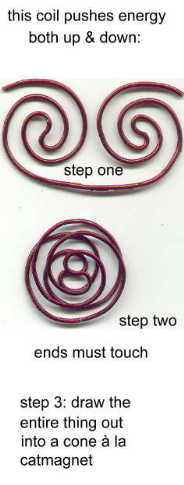 Determine the wire length you wish to use.
Determine the wire length you wish to use.
Measure and mark the halfway point as well as the 2 quarter-way points.
Make one catmagnet coil centered at one of the quarter-way points. Stop twisting as you approach halfway mark.
Make the other at the other quarter-way point, in such a fashion that it rolls toward the first one as pictured.
Roll the halves together as in bottom picture. Tweak it as necessary. Try to align the S-shaped centers so that they interface into an infinity symbol (I don't know how important this is, but it looks better).
Note: the 2 coils are not interlaced in any way; one lays on top of the other.
It can be used flat (useful for pendants) but I think the energy is a bit better if the 2 centers are pulled either away from each other ("DT" shape) or toward the same direction, into a shallow dome shape.
Also see my page on neatness and cat coils for an important tip that applies to loohan coils as well.
Double-terminated version AKA Aikido Coil:Warning! This coil and the Little Secret coil are the most difficult coils I make. Not for everyone. The Potbelly Coil, for example, is far easier.
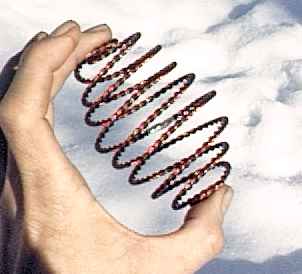 Heh-heh! This "double-terminated" baby cooks! 53.3" doubled, twisted 14 gauge magnet wire; twisted wire and jerrification makes a huge difference.
Heh-heh! This "double-terminated" baby cooks! 53.3" doubled, twisted 14 gauge magnet wire; twisted wire and jerrification makes a huge difference.
I think of the "double-terminated" version as an "aikido coil" because of the way it processes energy. In aikido, incoming energy is accepted in a circular, spiralic fashion, and is transformed by spinning around the center of the person who was attacked. Also, it is about resolving conflict by healing the attacker, or putting him in harmony with the order of the universe. Being thrown in aikido brings a smile to the face.
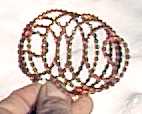 Incidentally, note that the coil (NOT the wire) has a counterclockwise wind. This coil is similar to 2 cat coils wound to direct energy toward their bases. One could wind it clockwise, instead. But I have a fondness for "bucking" energy toward itself from 2 sources, whether it be cat coils, or whatever.
Incidentally, note that the coil (NOT the wire) has a counterclockwise wind. This coil is similar to 2 cat coils wound to direct energy toward their bases. One could wind it clockwise, instead. But I have a fondness for "bucking" energy toward itself from 2 sources, whether it be cat coils, or whatever.
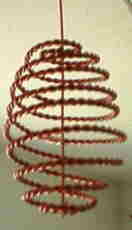 Same coil now cookified and hung from ceiling.
Same coil now cookified and hung from ceiling.
Update: Making these type of coil is difficult enough without having to mess with springy twisted wire.
I find it more rewarding to just use a heavy single annealed wire lately.

103.3" of 4g wire
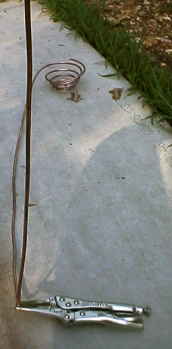 I am realizing lately that, especially when using thick wire, it is important to start the second half at a 90 degree angle from where you want it to end up. Somehow, when I make that second S, it distorts the relationship with the other coil by that much.
I am realizing lately that, especially when using thick wire, it is important to start the second half at a 90 degree angle from where you want it to end up. Somehow, when I make that second S, it distorts the relationship with the other coil by that much.
The picture depicts the right way to do this: at least if your coil has the same direction of wind as depicted (CCW ascending) and if the first coil is resting on a plane as shown, then you want to bend up from that plane to form the S.
This probably only holds true for the double-terminated version, the way I make them, i.e. I form the cat coils as I make the coil, rather than pulling them out later.
About connecting the ends:
I use 3 layers of metal tape. First, a layer of aluminum tape (only because my copper tape, sold for stained-glass work, is only 3/8" wide, too narrow to hold fat wire together). Then, a short piece of silver-coated copper tape, wrapped around the joint once. This seems to help the energy quality. Then I cover this mess with with a clockwise-spiraling plain copper tape wrap.
One should apply at least some of the principles of eclectic layering on the joints of these. I write/draw mirror-image-wise on the metal tapes. This drives significant energy into the coil. On larger-gauge coils, for additional orgone accumulation, I may use cellophane tape between the layers of metal tape, as well as using more than 3 layers of metal tape, though these practices produce a goodly bulge.
Summary of how to make more powerful passive coils
return to coil info page
Determine the wire length you wish to use.
Heh-heh! This "double-terminated" baby cooks! 53.3" doubled, twisted 14 gauge magnet wire; twisted wire and jerrification makes a huge difference.
Incidentally, note that the coil (NOT the wire) has a counterclockwise wind. This coil is similar to 2 cat coils wound to direct energy toward their bases. One could wind it clockwise, instead. But I have a fondness for "bucking" energy toward itself from 2 sources, whether it be cat coils, or whatever.
Same coil now cookified and hung from ceiling.
I am realizing lately that, especially when using thick wire, it is important to start the second half at a 90 degree angle from where you want it to end up. Somehow, when I make that second S, it distorts the relationship with the other coil by that much.
 home products ordering return to coil info page
home products ordering return to coil info page